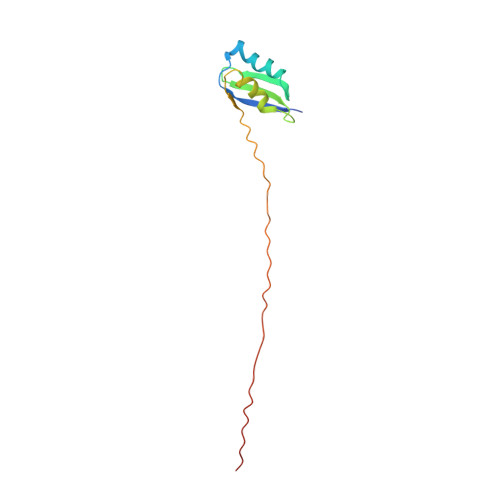NMR structural analysis of the soluble domain of ZiaA-ATPase and the basis of selective interactions with copper metallochaperone Atx1.
Banci, L., Bertini, I., Ciofi-Baffoni, S., Poggi, L., Vanarotti, M., Tottey, S., Waldron, K.J., Robinson, N.J.(2010) J Biol Inorg Chem 15: 87-98
- PubMed: 19609573
- DOI: https://doi.org/10.1007/s00775-009-0568-7
- Primary Citation of Related Structures:
2OFG, 2OFH - PubMed Abstract:
A Cu(I) metallochaperone, Atx1, interacts with the amino-terminal domain of a Cu(I)-transporting ATPase, PacS(N), but not with a domain of related Zn-transporting ATPase, ZiaA(N) in Synechocystis PCC 6803. This is thought to prevent ZiaA(N) from acquiring Cu(I), which it binds more tightly than Zn. Solution structures of Atx1, PacS(N), and the heterodimer were previously described. Here we report solution structural studies of the ZiaA(N) soluble domain. Apo-ZiaA(N) has a typical ferredoxin-like fold followed by an atypical 34 residues of unstructured polypeptide containing a His(7) motif. ZiaA(N) competes with the metallochromic indicator 4-(2-pyridylazo)resorcinol for 1 equiv of Zn, which can be displaced by thiol-modifying p-mercuriphenylsulfonic acid, establishing that a high-affinity site involves thiols of the CXXC motif within the ferredoxin-like fold. A single equivalent of Zn affects nuclear magnetic resonance signals arising from the CXXC motif as well as all seven His residues. The presence of NMR-line broadening in both sites implies that Zn(1)-ZiaA(N) undergoes exchange phenomena, consistent with CXXC-bound Zn coincidentally sampling various His ligands. These Zn-dependent dynamic changes could either aid metal transfer or alter intramolecular interactions. No formation of Atx1-Cu(I)-ZiaA(N) heterodimers was observed, and in the presence of equimolar ZiaA(N) and PacS(N), only Atx1-Cu(I)-PacS(N) complexes were detected. Residues flanking the CXXC motif of PacS(N) (R(13)-ASS(20)) differ in charge and bulk from those of ZiaA(N) (D(18)-KLK(25)) and make contacts in the Atx1-Cu(I)-PacS(N) complex. Crucially, swapping these residues flanking the CXXC motifs of ZiaA(N) and PacS(N) reciprocally swaps partner choice by Atx1. These few residues of the two ATPases have diverged during evolution to bias Atx1 interactions in favor of PacS(N) rather than ZiaA(N.).
- Magnetic Resonance Center, University of Florence, Sesto Fiorentino, Italy.
Organizational Affiliation:
















